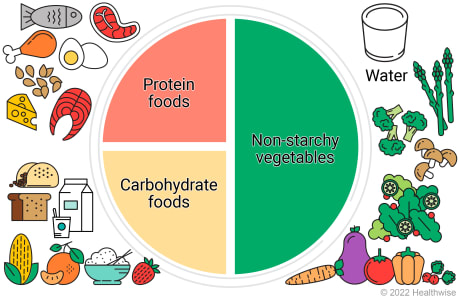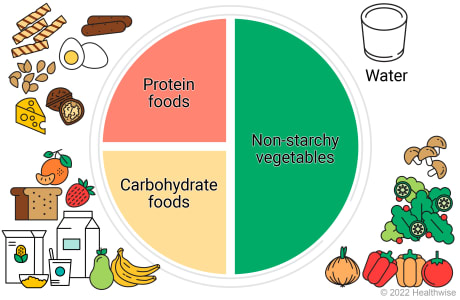Top of the pageActionset
Diabetes: Using the Diabetes Plate Method to Plan Meals
The diabetes plate method is a simple way to plan meals and manage the amount of carbohydrate you eat. Put non-starchy vegetables on half your plate. Add protein foods, like meat or meat substitutes, on a fourth of the plate. Put carbohydrate foods, like grains, starchy vegetables, beans, fruit, and milk and yogurt, on the final fourth of the plate. Choose water or another low-calorie beverage to drink with your meal.
How to use the diabetes plate method
Here is a simple way to manage the amount of carbohydrate you eat at meals.

Follow these guidelines for lunch and dinner. Use a plate that measures 9 inches (23 cm) across.
- Half the plate is non-starchy vegetables. Some examples are broccoli, carrots, cauliflower, mushrooms, peppers, and salad greens.
- A fourth of the plate is protein foods. These include chicken, turkey, lean beef and pork, fish, tofu, nuts, eggs, and cheese.
- A fourth of the plate is carbohydrate foods. These include grains, fruit, yogurt, and starchy vegetables like potatoes, corn, and beans. If you drink milk with your meal, it counts for this section of your plate.
- Choose water or another low-calorie drink. Water is a good choice with meals. Other examples of low-calorie drinks include sparkling water or unsweetened tea or coffee.

For breakfast, the concept is similar.
- Half the plate is non-starchy vegetables. You can leave this section of your plate empty if you don't usually eat vegetables at breakfast.
- A fourth of the plate is protein foods.
- A fourth of the plate is carbohydrate foods.
- Choose water or another low-calorie drink.
Credits
Current as of: July 7, 2025
Author: Ignite Healthwise, LLC Staff
Clinical Review Board
All Ignite Healthwise, LLC education is reviewed by a team that includes physicians, nurses, advanced practitioners, registered dieticians, and other healthcare professionals.
Current as of: July 7, 2025
Author: Ignite Healthwise, LLC Staff
Clinical Review Board
All Ignite Healthwise, LLC education is reviewed by a team that includes physicians, nurses, advanced practitioners, registered dieticians, and other healthcare professionals.





